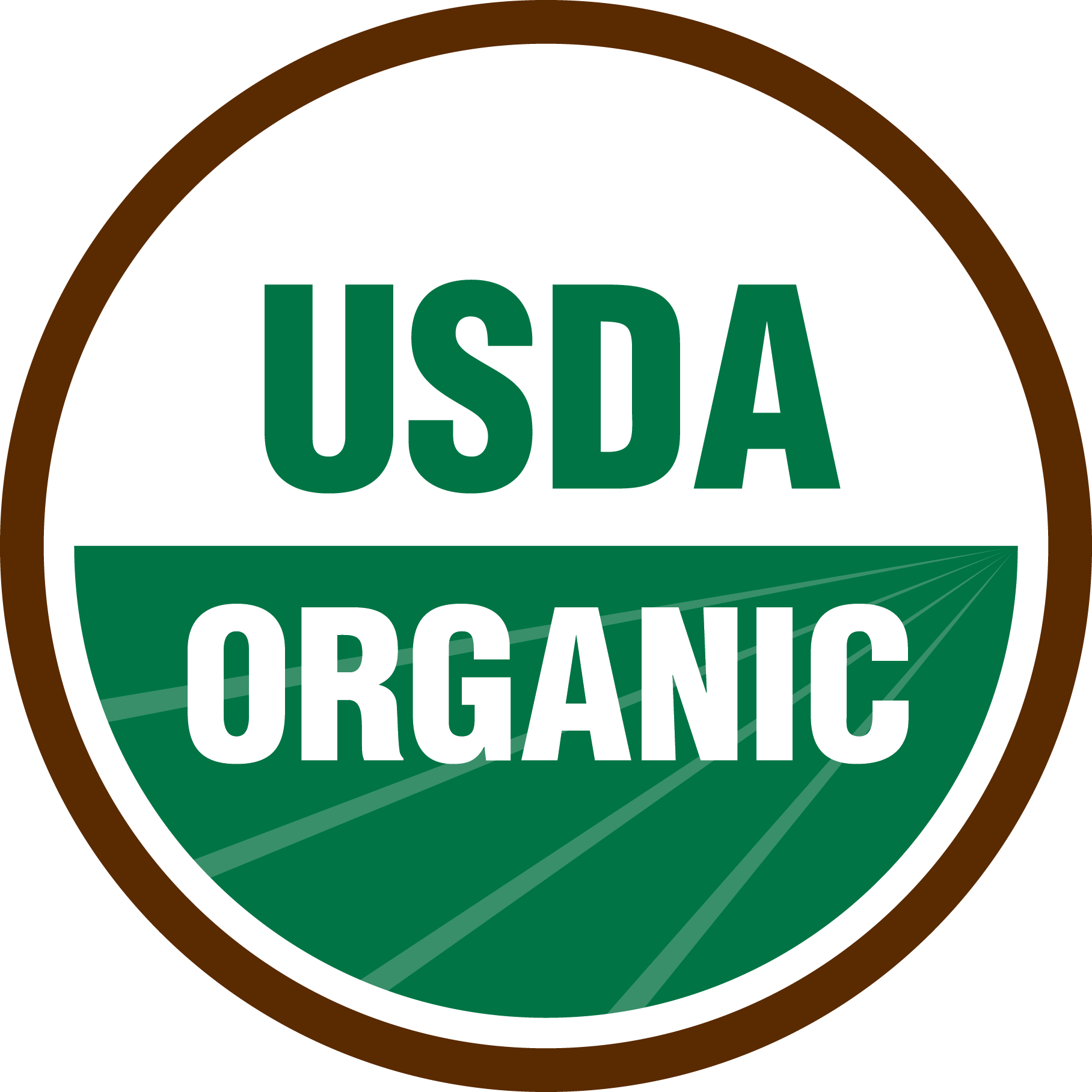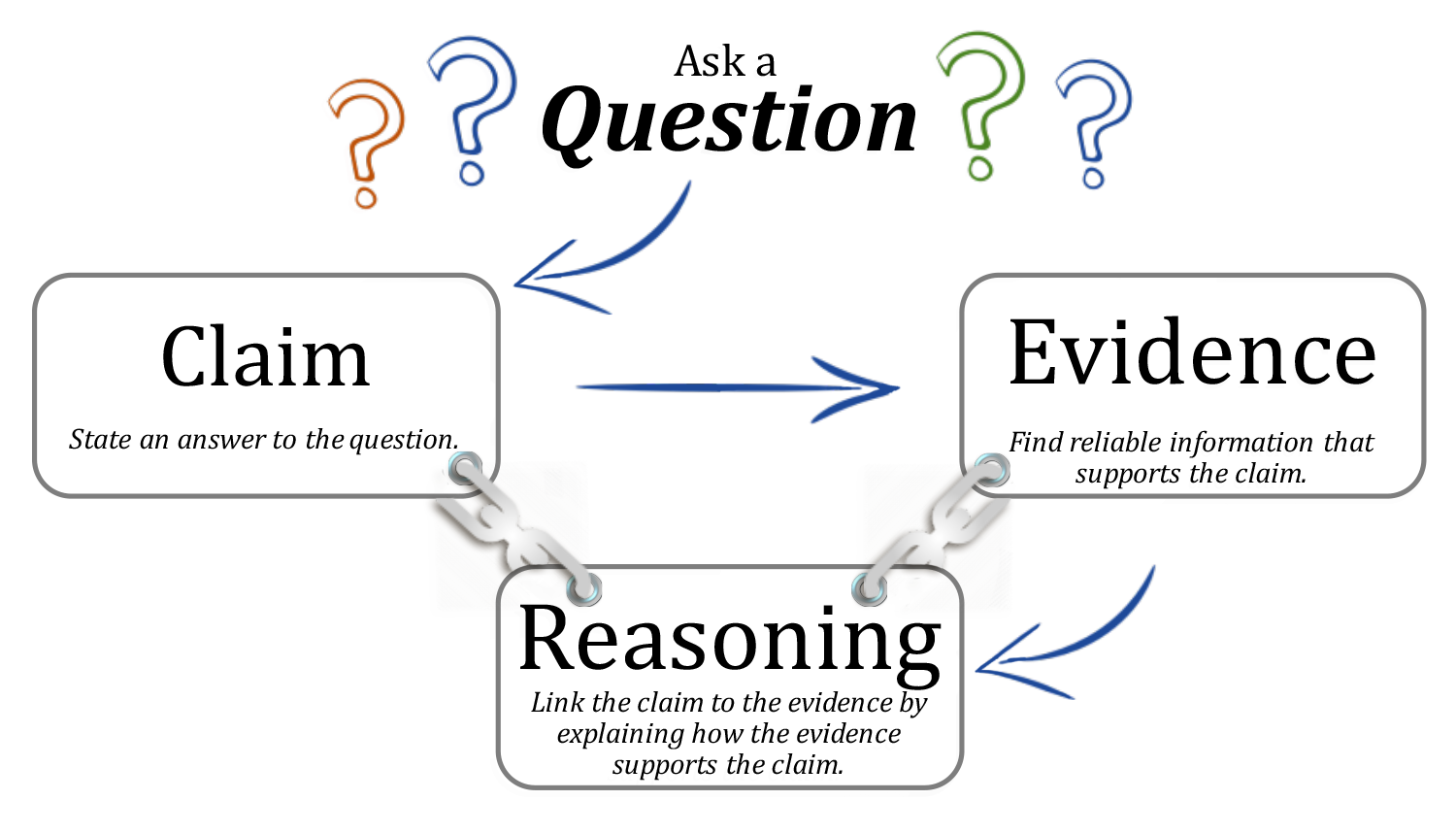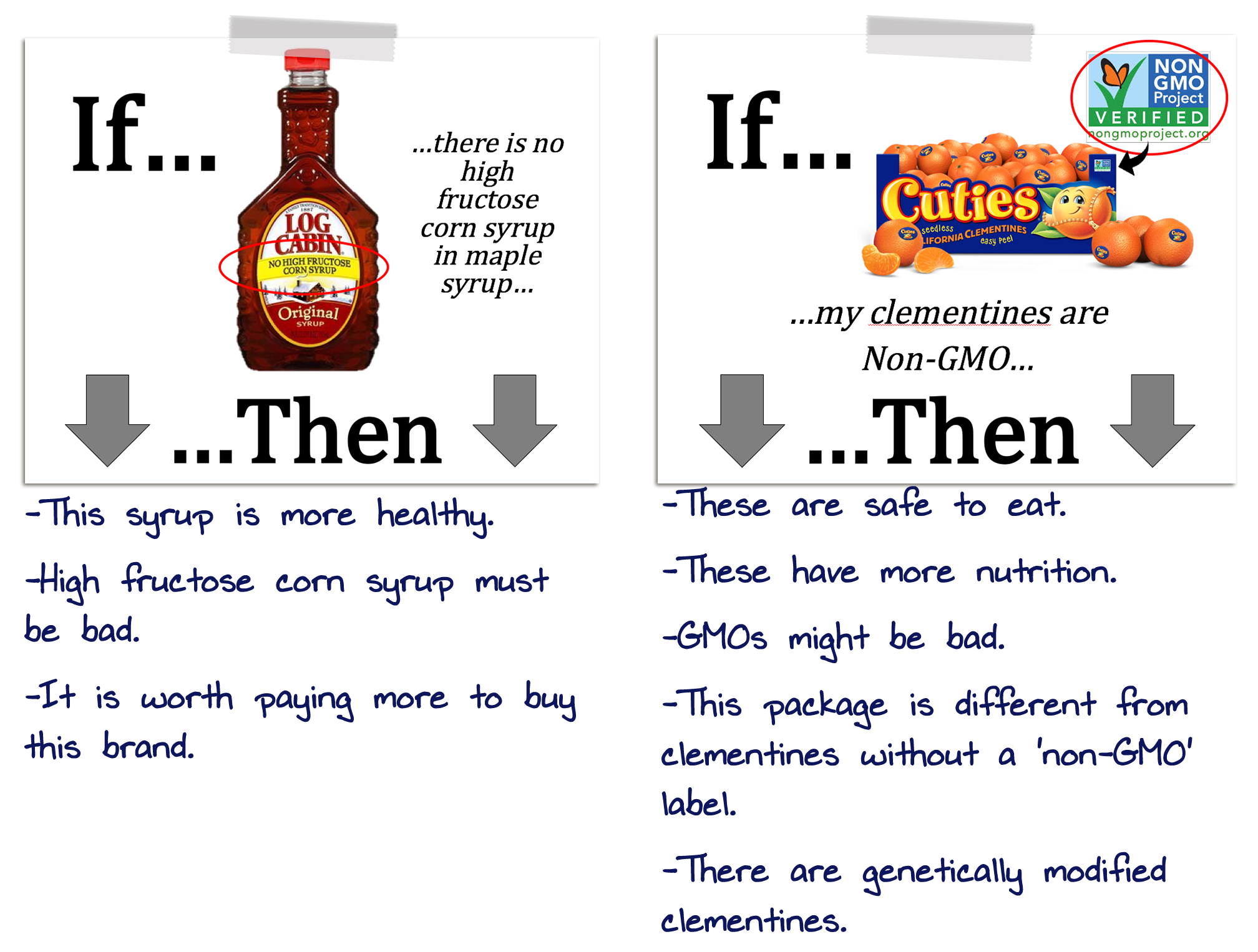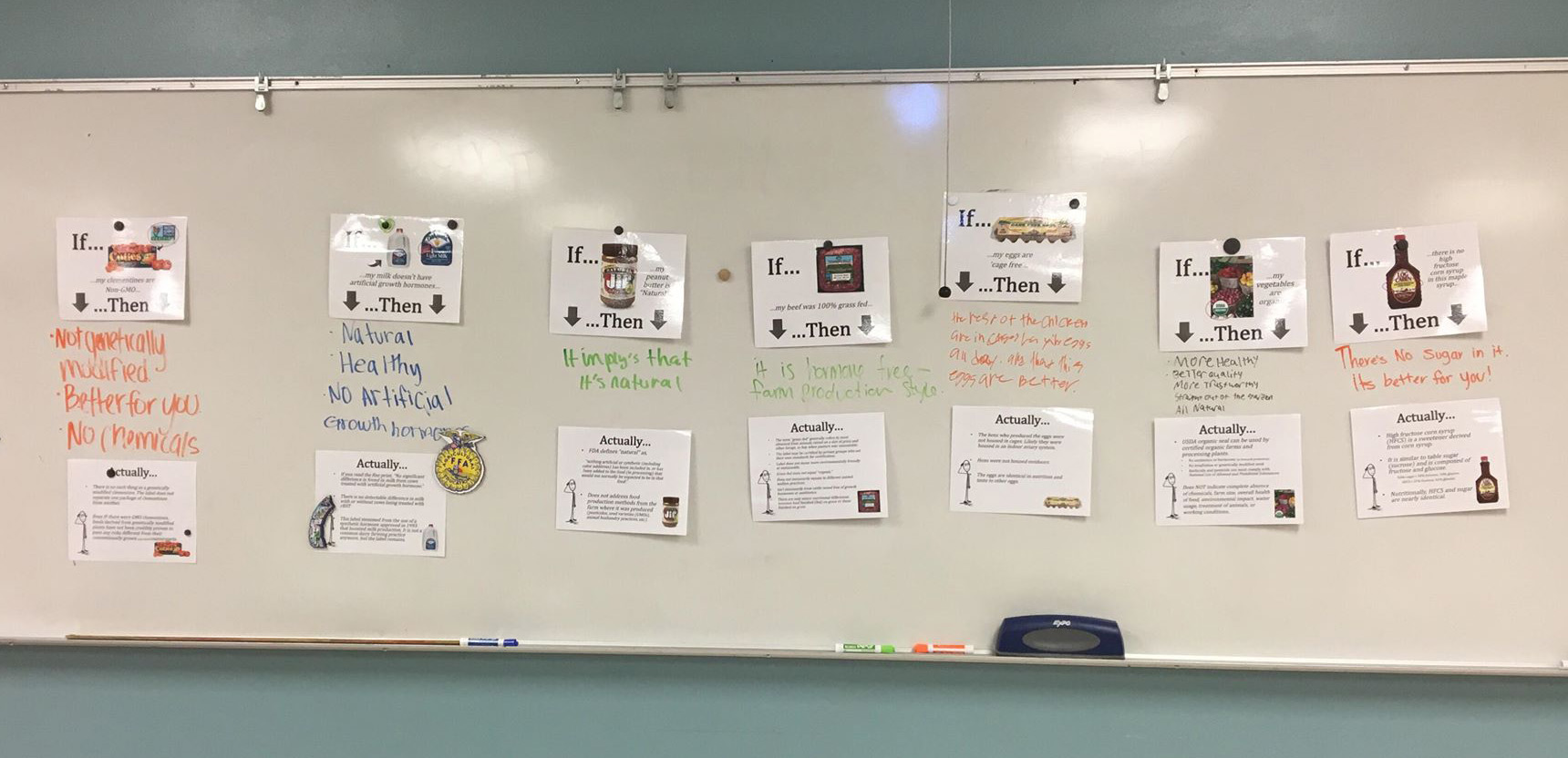Reading Food Labels Health Lesson Plan Elementary Powerpoint
Lesson Plan
Looking Under the Label
Purpose
Students volition evaluate food package labels, determine their meaning, and use the Claim, Show, and Reasoning model to determine the value of the label in relation to nutrient production practices, nutrition, health, and nutrient safety. Students will engage in critical thinking to recognize the impact of food package labels in relation to marketing, consumer perceptions of food, and farming practices.Grades nine-12
Vocabulary Words
conventional: term used to classify farming methods that employ technology such as synthetic fertilizers, pesticides, herbicides, or biotechnology
FDA: acronym representing the U.S. Food and Drug Assistants
fertilizer: any material of natural or synthetic origin that is practical to soils or found tissues to supply one or more nutrients essential to plant growth
genetically modified organism (GMO): whatever organism whose genetic material has been altered using genetic engineering techniques
organic: term used to allocate farming methods that limit the use of some mutual practices such as biotechnology and types of fertilizer or pesticide
pesticide: a chemic that is used to control an organism living and growing where information technology is non wanted
USDA: Usa Section of Agriculture
Did You lot Know? (Ag Facts)
- In a global study most consumer perceptions of a food labeled organic, 82% of respondents believed the product was chemical/pesticide gratis, 75% thought the production was safer, 68% believed it was better for the surroundings, and 67% believed it was more nutritious.1
- The give-and-take natural on a nutrient characterization means that nothing bogus or synthetic (i.e., colors or dyes) has been included in or added to the nutrient in processing. It does non accost the farming practices used on the subcontract such every bit using GMO seed varieties or pesticides.2
- Fruits and vegetables are the most mutual organic foods that consumers purchase in the United States.3
Background Agricultural Connections
Down every aisle and independent on every package of food in a grocery shop, a consumer finds labels on their nutrient. Some labels make claims virtually the diet content or the healthfulness of the food. Other labels indicate production styles good on the farm where the nutrient was produced. Some food labels in the United states are regulated with gear up requirements by the U.S. Food and Drug Assistants (FDA)or by the United States Department of Agriculture (USDA) Food Safety and Inspection Service (FSIS). Other types of labels are not regulated by government or private agencies. They are added by food companies as part of their marketing plans to promote the product.
Labeling for Nutrition
The FDA is responsible for assuring that foods sold in the U.s.a. are safe, wholesome, and properly labeled. This applies to foods produced hither in the Us as well as those imported from strange countries. The Nutrition Labeling and Didactics Act (NLEA) requires that most foods incorporate a Nutrition Facts label. In addition, diet content claims and health letters contained on product packaging must also comply to specific requirements.iv The FDA publishes A Food Labeling Guide outlining specific labeling requirements in many areas including:
- Location of labels on food packaging
- Proper name of food
- Ingredient lists (including colors and food allergens)
- Diet Facts
- Nutrient content claims (a merits on a food characterization direct characterizing the level of a nutrient in the food)
- Health claims (a claim describing the relationship between a nutrient and the reduced hazard of a disease or health-related conditions)
Farm production System Food Labels
 Increased consumer involvement in the source of our food and the methods used to produce it has led to more frequent use of food production terms and labels to classify our food. Many of these labels indicate the production system that was used (or not used) on the farm where the food was produced. Almost all foods are produced on farms using either organic or conventional methods of farming. Both systems must manage soil health, pests, and weeds in crop production equally well as make decisions apropos housing, diet, and health direction in livestock production. However, they use different tools and production methods. An organic crop subcontract is express to fewer substances that can be used for fertilizer and pesticides. They also cannot use genetically modified (GMO) varieties of seed.five In dissimilarity, conventional-style crop farms can use GMO seed if desired (and available) as well as constructed forms of fertilizer or pesticide. Organic animal-origin foods such every bit meat, milk, and eggs are produced on farms meeting specific requirements. For example, animals are housed in living conditions that suit their natural behaviors, they are fed organic feed, and the animals are not given antibiotics or hormones.5 Foods produced on a USDA certified organic farm contain the green and white "USDA Organic" characterization.
Increased consumer involvement in the source of our food and the methods used to produce it has led to more frequent use of food production terms and labels to classify our food. Many of these labels indicate the production system that was used (or not used) on the farm where the food was produced. Almost all foods are produced on farms using either organic or conventional methods of farming. Both systems must manage soil health, pests, and weeds in crop production equally well as make decisions apropos housing, diet, and health direction in livestock production. However, they use different tools and production methods. An organic crop subcontract is express to fewer substances that can be used for fertilizer and pesticides. They also cannot use genetically modified (GMO) varieties of seed.five In dissimilarity, conventional-style crop farms can use GMO seed if desired (and available) as well as constructed forms of fertilizer or pesticide. Organic animal-origin foods such every bit meat, milk, and eggs are produced on farms meeting specific requirements. For example, animals are housed in living conditions that suit their natural behaviors, they are fed organic feed, and the animals are not given antibiotics or hormones.5 Foods produced on a USDA certified organic farm contain the green and white "USDA Organic" characterization.
The comparison of organically and conventionally produced foods has been the topic of many research studies.vi While some pocket-size differences do occur, significant differences (in nutrient value and overall food safety) have not been plant. Published literature does non provide an obvious divide between organically and conventionally grown food.7 Yet, many myths and misconceptions are turned into erroneous food product claims.8 Organic production practices are besides touted as being more sustainable. However organic farmers use some practices such as tillage to command weeds and that may involve more fossil fuels and thereby increase carbon dioxide emissions. To really make a comparing between the two systems requires research into each specific crop to determine which method is more sustainable. Consumers should empathize the similarities and differences between organic and conventional produced food to make informed evidence-based decisions and not assume that "natural" (oft uses synonymously with organic) is better or more than sustainable than using tools and precision agriculture techniques to grow a crop.
In improver to dividing conventional and organic farming practices, food labels may also indicate the type of seeds used for crops (non-GMO), the way of housing an animal was raised in (cage-free or gratis range), the type of nutrient they ate (grass-fed), or if animals were treated with antibiotics, feed additives, or growth hormones to treat sickness or promote growth.
Touch of Labels
Bated from the evaluation of farming methods, nutrient labels may impact consumer perceptions and choices regarding the food they buy. Following the laws of supply and need, consumer choices likewise touch on the choices farmers make in producing our food. Throughout this lesson, teachers tin use the Claim, Testify, and Reasoning model to encourage critical thinking and to allow students to empathise what is really "under the labels" on their food.
Interest Arroyo - Engagement
- On the day prior to this lesson, assign students a scavenger hunt homework action. Tell the students that they need to find and photo 10 different food package labels or logos. Let them know that they tin notice and photo these labels in a grocery store or in their home cupboards/pantry. As criteria, let them know that any label, logo, or text giving further information about the food product is acceptable, but that all ten need to be different. Students should have a picture of each label and then may utilize an app to put all x labels into a single collage. Display an case for farther clarification.

- Before class, carve up your whiteboard into the sections/columns listed below. As students come into class, instruct them to look at their label collage and place the text or a sketch of five (or more) of their x labels on the lath in what they call back is the correct category.
- Nutrition Facts labels
- Wellness Claim labels
- Food Content labels
- Agricultural production System labels
- Once students take recorded their labels on the board, inquire them, "What kind of messages are these labels communicating?" Permit students to offering their thoughts. Follow up with questions such equally:
- Could a label atomic number 82 a consumer to believe one nutrient is "better" (more nutritious or safer) than another?
- Could a label influence a consumer to pay additional coin for a specific nutrient?
- Are there labels that could be misleading in whatsoever mode?
- Bear witness the, All Natural, Non-GMO, 100% Gluten Costless Internet Video. Subsequently the video prune, point out that the labels on our food, don't lie, but sometimes they create perceptions that are not true. Discuss the case from the video prune, genetically modified (GMO) milk does non exist, could a consumer perceive that milk labeled "non-GMO" has a college value or increased safety and nutrition over a milk that is not labeled "non-GMO?" (yes)
Procedures
Activity ane: Touch on of Labels on Marketing and Consumer Perceptions
- Define the wordimply every bit, "to strongly propose the truth or beingness of something not expressly stated."
- Split your class into viii small-scale groups and give each grouping one If... Then... food label card.
- Instruct students to read their card and brainstorm what messages may exist implied from the food bundle label. Point out that words on a label tin imply messages in numerous categories.
- Tip: To help students retrieve more nearly the "large picture," project the Looking Under the Label PowerPoint (slide 3) on the lath or give each group a hard re-create. Encourage them to think almost categories such equally nutrient safety, nutrition, economics, impact on the surround, creature welfare, etc.

- Tip: To help students retrieve more nearly the "large picture," project the Looking Under the Label PowerPoint (slide 3) on the lath or give each group a hard re-create. Encourage them to think almost categories such equally nutrient safety, nutrition, economics, impact on the surround, creature welfare, etc.
- Once students have brainstormed as a group, instruct them to adhere their carte to the lath with tape or a magnet and list what is implied by the nutrient label beneath the card.
- Once each grouping has recorded on the lath what they believe the labels accept implied, review each label as a class and add the Actually... card to the board which will ascertain and give clarity to the meaning of each label.
- After discussing each label, have the grade determine if the characterization "tells you" nigh the food or if it "sells yous" a food. Answers may vary, and in some cases, your students could choose both. Utilize the following guidelines to determine:
- Labels that Tell You:These labels identify foods with an objective (measurable) difference from 1 package or make to another. An ideal example from the activity is the "No Added Sugar" characterization. This claim tin can be measured (grams of sugar) and verified using the Nutrition Facts Characterization which is regulated by the FDA. Choosing a nutrition with foods low in added sugar has been scientifically proven to assistance people maintain a healthy weight.
- Labels that Sell You:These food labels separate foods that don't really comprise a measurable difference in prophylactic, diet or other factors. While these foods may be produced in different means (eggs produced by chickens housed in cages verses hens in gratuitous-range housing), the end production provides the same levels of food safety, quality, and diet.
- Summarize the activity past concluding that labels impact consumer choices. Some labels tell us a lot about foods, and other labels are for marketing purposes and tin can create misconceptions.

Action ii: Nutrient Labels 101
- Requite each student 1 copy of the Food Labels 101 activity sheet.
- Project the Looking Under the Label PowerPoint (slide 5). Describe each of the four categories of food labels and instruct students to add the definition of each to their activity sheet.
- Open theLooking Under the Label: Categorizing Nutrient Labels Kahoot or Quizizz. Utilize the game as a review and formative cess. Students will be shown fifteen food labels and volition categorize them accordingly.
- For added clarity, point out the following equally you go through the Kahoot:
- The Nutrition Facts label and Food Content claims can have some of the same information. Nutrition Facts are found on the side or back panel of the package. They are required by police on all foods with nutrient content. Nutrient Content Claims are plant on the forepart of the package and are voluntarily placed by nutrient processing companies to help market their product.
- Whatever logo, label, or text describing the farm where the food was produced would be considered a Farm Product System label.
- Some labels are regulated and others can exist voluntarily placed past nutrient companies for advertising and promotion of the product.

Activeness 3:Production Style Food Labeling
- Now that students have been introduced to some of the psychology and marketing of food labels and they can recognize the types of labels that can be establish on food packages, inform students that you volition exist focusing on some of the most common farm production fashion labels found on foods today.
- The commencement question you will be answering is, "What does it mean if a food is labeled as organic?" Share the Did You Know (Ag Facts) listed at the beginning of the lesson programme. Explain that you volition illustrate what organic means with an analogy.
- Using the Looking Under the Label PowerPoint, testify students a moving picture of a tree (slide vii). Explain to them that the tree needs to be removed. Conclude with your students that you will need a tool to accomplish the task. Ask for student volunteers to offer ideas of tools that can be used to remove the tree. Students may call back of an ax, paw saw, chain saw, or fifty-fifty a highly automatic tree harvesting machine (slide 8).
- Ask the post-obit questions:
- Will each of these tools achieve the goal of removing the tree? (yes)
- Are there pros and cons associated with the use of each tool? (yes)
- Could dissimilar people see different aspects of each tool and take a different opinion of which tool is "best?" (yes)
- What are some pros and cons of each tool? (An ax and hand saw require a lot of physical exertion and would take longer to cut down a tree. A chain saw or tree cutting car requires fuel and is more expensive to buy simply would perform the job much faster.)
- After summarizing that at that place are different tools that tin attain the same task, explicate that farmers also have many different "tools" to produce our nutrient. For case, farmers utilise tools to control weeds and pests that damage and kill crops likewise as diseases in both crops and animals. The type of "tool" or technique a farmer has used to produce a crop (found or fauna) is sometimes noted by a specific characterization on a nutrient package. The "organic" characterization is an example.
- Explain that Organic farms represent a portion of farms in the United States. Well-nigh farms in the United States are known asconventional farms. They use some of the aforementioned "tools" as organic farms, but take a few more options to cull from.
- Scout the video prune, Give it a Minute: Organic and Conventional Farming to run into the similarities and differences in organic and conventional farming methods.
- Summarize that foods labeled as "organic" were produced past a farmer who used different tools or techniques than a farmer who produces food on a conventional farm. In addition to the organic label, there are many more than nutrient labels that draw the tools or technologies used (or not used) on farms where our food was produced.
- Using PowerPoint slides x-12 give three examples of different farming practices that are depicted by labels on food. Continue using the analogy of "tools" to illustrate that labels tin signal what type of tools or techniques farmers employ in the production of nutrient.
Concept Elaboration and Evaluation
- (Slide 13) Define the discussionpsychology for students as, the scientific study of the human heed and its functions, especially those affecting behavior in a given context. Ask, "Tin can psychology impact consumer decisions about food?" (yep!)
- Using PowerPoint slide 14, talk over with students why we as consumers seek and avoid specific things when we are shopping for food.
- Innovate the concept of confirmation bias (slide xv). Ask students to call up of examples of confirmation bias in their lives. Prompt them to think of things they accept been told and viewpoints they take seen or read on the internet or social media. Refer dorsum to the example labels given in theIf...And then... food cards used inActiveness 1. Ask students, "Could confirmation biases impact consumers' beliefs about their foods? (perhaps) "Practice labels impact confirmation bias?" (yes)
- Inquire students, "Why is this important?.... and then what?" Explicate to students that our grocery store choices ripple through the agronomics manufacture (slide sixteen) , impacting how farmers produce crops and livestock and how food manufacturers process, label, and market their products. Review the laws of supply and demand. It's important for consumers to understand the nutrient choices they are given and to select the option that will create a positive change when because all factors (slide 17). Some labelstell virtually a food product and the practices used to produce it. Other labelssell a product with labels that mean very niggling and create misconceptions almost food and modern farming methods.
- Challenge students to think critically about ALL nutrient labels they run across, especially those indicating the type of practices used on the farm where it was produced. Hash out what your students perceive every bit the pros and cons of these labels in our food system.
| | Deceptions can be constitute on nutrient labels. Rather than pointing out erroneous label content, allow and encourage students to think critically about what nutrient packaging labels mean and evaluate the claims. Inquire them to consider how consumer perceptions and biases may influence the search for show, and how credible evidence should influence conclusion making. |
Concept Elaboration and Evaluation
After conducting these activities, review and summarize the post-obit key concepts:
- Nutrient labels impact consumer choices.
- Consumer choices impact choices farmers make in the production of our food. This tin can lead to positive change besides as potentially negative changes.
- Some types of food labels are regulated by the FDA with guidelines for their use and others are not regulated and are used to market place foods.
Enriching Activities
-
To increase student understanding of the "non-GMO" food label, do the Involvement Approach activity from the lesson, Evaluating GMO Perspectives Through Labeling. This action demonstrates to students the types of foods that may and do not contain ingredients from a genetically modified plant. After learning about the x plants that accept a commercially approved GMO diversity in the U.s., students will exist able to recognize which labels accordingly identify a nutrient that could have genetically modified ingredients from foods that practise not have a GMO counterpart and are simply labeled non-GMO for marketing purposes.
-
Have students consummate a Venn Diagram to place the similarities and differences between conventional and organic farming practices.
-
Explore the significant of production way egg labels. Requite students a video tour of Burnbrae Farms, a large egg farm in Canada with several styles of hen-housing. Have students watch each video and compare and contrast the benefits and disadvantages for each housing system in a T-nautical chart. After completing the activity, students should recognize that when accounting for all factors in that location is no single "best" or "worst" organisation. Each producer and consumer chooses their preference. These consumer choices create a market place that follows the laws of supply and need.
- Conventional Hen Housing
- Complimentary Run Housing (Cage-free)
- Complimentary Range Housing
- Enriched Colony Housing
-
Listen to the NPR broadcast, Organic Pesticides: Not An Oxymoron. Hash out pupil thoughts and the affect of the "organic" label.
-
Learn more about the USDA Organic seal past visiting the National Organic Program website besides as studying infographics that describe qualifications of labeling. Take students discuss their perceptions of the label and anything they are surprised by.
-
Read the article, "Don't Exist Fooled by Food Labels" to swoop deeper into the meaning of more food labels.
Organization Affiliation
National Middle for Agricultural Literacy
| | Nosotros welcome your feedback. Please accept a minute to share your thoughts on this lesson. |
Reading Food Labels Health Lesson Plan Elementary Powerpoint
Source: https://agclassroom.org/matrix/lesson/655/
0 Response to "Reading Food Labels Health Lesson Plan Elementary Powerpoint"
Post a Comment